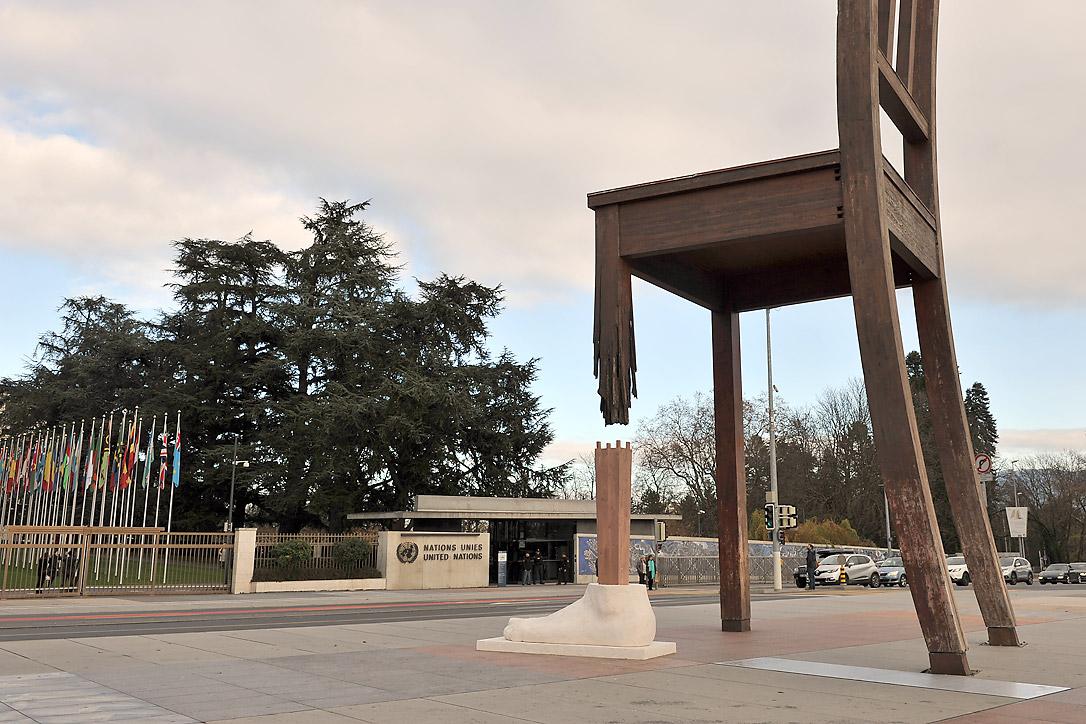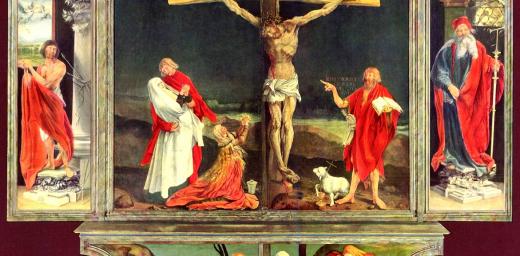A defiant symbol of power and suffering

Photo: LWF/I. Benesch
The “Broken Chair,” an impressive wooden sculpture in front of the Palais des Nations in Geneva (the United Nations Office at Geneva), Switzerland, depicts a giant chair with a broken leg. It was constructed on the initiative of Paul Vermeulen of Handicap International Suisse in August 1997 during negotiations prior to the signing of the Mine Ban Treaty.
When I look at the chair, my eyes automatically focus on what is missing: the broken leg, symbolizing people’s limbs blown away by landmines. The chair is a symbol of the suffering and pain of innocent civilians—men, women and children.
Initially, the chair was supposed to remain in front of the UN for three months. It was conceived as a temporal symbol, a stark reminder of the serious negotiations taking place inside the Palais. However, it has been standing there for 18 years, with a brief interruption during the time when the city undertook major reconstruction work on the square opposite the main entrance to the UN. The decision to keep the chair outside the UN was made so that we do not forget that significant countries have, until today, not signed and ratified the treaty.
When Vermeulen developed the idea for a monument, he did not want a stone statue because human bodies are not hard or eternal like stone. He felt that wood was organic, rather like human flesh and bone, and thus vulnerable. Yet the chair, like so many land mine victims, stands firmly, almost defiantly against its handicap.
After a friend of mine visited Geneva, she told me that what had stuck in her mind was the Broken Chair—a powerful memorial to the victims of landmines. It is striking that to a certain extent it also symbolizes Geneva, a city of meetings. People here spend many hours at negotiation tables, sitting on negotiation chairs. This ordinary piece of furniture, a chair, has become a symbol of power, its missing leg, a symbol of suffering.
Let the flower bloom
While aware of the negotiations on banning landmines, this topic became very much alive again when I was in Cambodia in June 2014, speaking at an interfaith training course for young people. We were hosted by the Metta Karuna Reflection Center in Siam Reap, a center run by the Jesuit Refugee Service. In Cambodia there are 64,000 landmine casualties, a number beyond my imagination.
One of the landmine victims, Channareth, spoke to the group of young adults. Sitting in a wheelchair he explained the situation in Cambodia and the international campaign to ban landmines. Channareth made a profound reflection on human existence, saying: “As humans we all have landmines in our hearts, but also a flower! What we need is to eliminate the landmine and let the flower bloom. Do you know when we let this flower bloom? When we help and do something for others.”
These words speak to me. I believe the flower to be a very strong and striking symbol in Asia: one of beauty and joy, tenderness and fragility, symbolizing life and meaning.
“Let the flower bloom”—We all know what Channareth means and we also know how difficult that is.
“Help and do something for others”—We all know what Channareth means and we also know how difficult it is.
The cross - a sign of God’s deep compassion
This week is the beginning of the season of Advent. During this time, Christians spiritually prepare for Jesus’ coming into this world. A small wooden manger was the place where Mary laid the little baby Jesus after his birth. In extraordinary ways Jesus embodied the call to “help and do something for others” as well as God’s profound love for this world during his lifetime. This made him vulnerable because no one is more vulnerable than the one who loves. The political powers sentenced Jesus to death and put him on the cross. For Christians, the cross is the sign of God’s deep compassion with this world and God’s steadfast love for humankind.
In Cambodia, I saw a small cross that touched me. On that cross you see Jesus with a missing limb. This is a strong symbol. Jesus identifies with the landmine victims. This Jesus, without a lower right leg, dignifies those whose limbs have been blown away. Jesus identifies with their suffering. And it is precisely this identification that generates hope: the hope that the shattered, fragmented and wounded lives will be healed, that the broken body will become whole again.
On the cross, Jesus suffers human sin in order to break the destructive spiral of sin and suffering. Jesus identifies with human suffering in order to bring healing to human existence.
What we see on this cross reflects ordinary people’s deep spirituality; this is deep theology. Lutheran theologians call this communicatio idiomatum, the communication or exchange of properties. In Jesus the human and divine come together, and in this coming together human and divine properties are exchanged: Jesus takes away sin and suffering from human beings and grants them integrity and wholeness. This communicatio idiomatum breaks the negative spiral and enables life in integrity. When we see that Jesus identifies with the fragmented life, our faith and our hope are nurtured.
Today, on the International Day of Persons with Disabilities, it is good to remember how Jesus related to all those who came to see him. He took them seriously, connected with them and opened new possibilities for their lives.
May God grant us God’s presence to accompany us during this time of Advent. May we sense that God identifies with our brokenness and fragmented lives. May God’s love overflow, touch our hearts, minds and bodies and strengthen our faith.
Rev. Dr Simone Sinn is Study Secretary for Public Theology and Interreligious Relations at the LWF.



